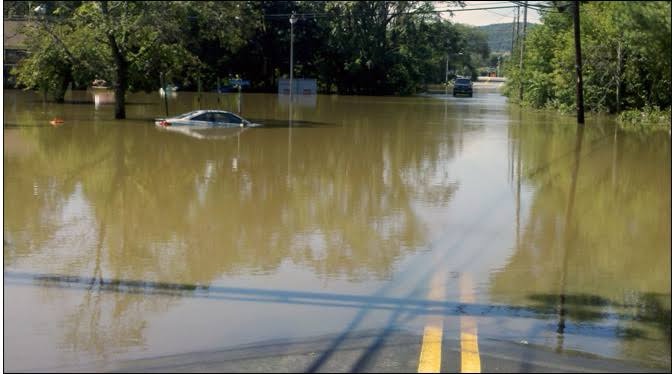NFL
BREAKING NEWS: With Two Confirmed Dead, New Jersey Governor Declares State of Emergency as Severe Flooding Overwhelms the State, Urging Residents to Stay Indoors and Avoid Travel

New Jersey Declares State of Emergency as Severe Flooding Overwhelms the State
On Tuesday, July 15, 2025, New Jersey Governor Phil Murphy declared a state of emergency due to “severe and ongoing flooding” that has gripped various parts of the state. The unprecedented rainfall has led to catastrophic flooding, submerging streets, disrupting transportation, and threatening homes and businesses across the region. This declaration comes as part of a broader response to what experts are calling one of the worst flooding events in recent history, exacerbated by the impacts of climate change.

Visual Evidence of the Crisis
Social media platforms, including X (formerly Twitter), have been inundated with videos and images capturing the extent of the flooding. One particularly striking video, shared by user Elly Bar, shows a subway train navigating through floodwaters, with passengers visibly concerned as water levels rise outside the windows. Another clip depicts a street scene where cars struggle to move through what has become a river of muddy water, highlighting the dire situation on the ground.
These visuals underscore the severity of the flooding, which has not only affected urban areas but also rural communities. The flooding has led to significant disruptions in daily life, with residents urged to stay indoors and avoid non-essential travel. Emergency services are working tirelessly to manage the crisis, but the scale of the event has stretched resources thin.
Infrastructure Under Threat
The flooding has had a profound impact on New Jersey’s infrastructure. Subway systems, roads, and bridges have been severely affected, with some areas experiencing complete submersion. The state’s Commissioner of Environmental Protection, Shawn LaTourette, noted on X that “when heavy rainfall overwhelms our infrastructure and the ground’s natural ability to absorb water, we see rapid rises in water levels in rivers, streams, and underground springs we never notice.” This statement reflects the broader challenge of managing flood risks in a state where 16% of the land lies in a floodplain.
Air travel has also been disrupted, with Newark Liberty International Airport (EWR) and LaGuardia Airport (LGA) in New York City experiencing ground stops due to the thunderstorms. The Federal Aviation Administration (FAA) announced these measures as a precaution, further illustrating the widespread impact of the flooding on transportation networks.
Climate Change Amplifies the Threat
Experts attribute the intensity of this flooding event to the broader effects of climate change. Recent studies, including those by the National Weather Service, have warned that extreme rainfall events are becoming more frequent and intense due to global warming. The Natural Resources Defense Council (NRDC) has highlighted that as sea levels rise and extreme weather events become more common, flood-prone areas are expected to expand significantly in the coming decades.
In New Jersey, the current crisis serves as a stark reminder of these warnings. The state has experienced record-breaking rainfall, with some areas receiving over 10 inches in a short period. This has overwhelmed the capacity of stormwater drainage systems, particularly in urban areas, leading to what is known as urban flooding. The remnants of Hurricane Floyd in 1999, which caused similar devastation, provide a historical parallel, but the current event is notable for its scale and intensity.
Emergency Response and Community Impact
Governor Murphy’s declaration of a state of emergency includes calls for residents to avoid unnecessary travel and stay indoors. Emergency measures are in place to manage the crisis, but the damage to homes, businesses, and critical infrastructure is already significant. Eight of New Jersey’s 21 counties, accounting for more than half of the state’s population, have been particularly hard-hit, with flash flood warnings remaining in effect until late evening.
The human toll of the flooding is also a major concern. Videos and reports from affected areas show residents grappling with the aftermath, with some areas experiencing power outages and others facing the risk of further flooding as water levels continue to rise. The emotional and financial strain on communities is palpable, with many residents unsure of when they will be able to return to normalcy.
Looking Ahead
As New Jersey navigates this crisis, the focus is on immediate response and long-term resilience. The state must address the immediate needs of its residents while also considering how to adapt to the increasing threat of flooding in a warming world. Infrastructure improvements, better stormwater management, and community preparedness are all critical components of a strategy to mitigate future risks.
The flooding in New Jersey is a microcosm of a larger global challenge. As climate change continues to exacerbate extreme weather events, states and cities across the United States and around the world must grapple with the reality of a new normal. For New Jersey, the current crisis is a call to action, urging policymakers, communities, and individuals to work together to build a more resilient future.
In the meantime, the images and videos from this event will serve as a powerful reminder of the fragility of our infrastructure and the urgent need to address the impacts of climate change. As the water recedes, the work of recovery and rebuilding will begin, but the lessons learned from this disaster will hopefully guide efforts to prevent such devastation in the future.












